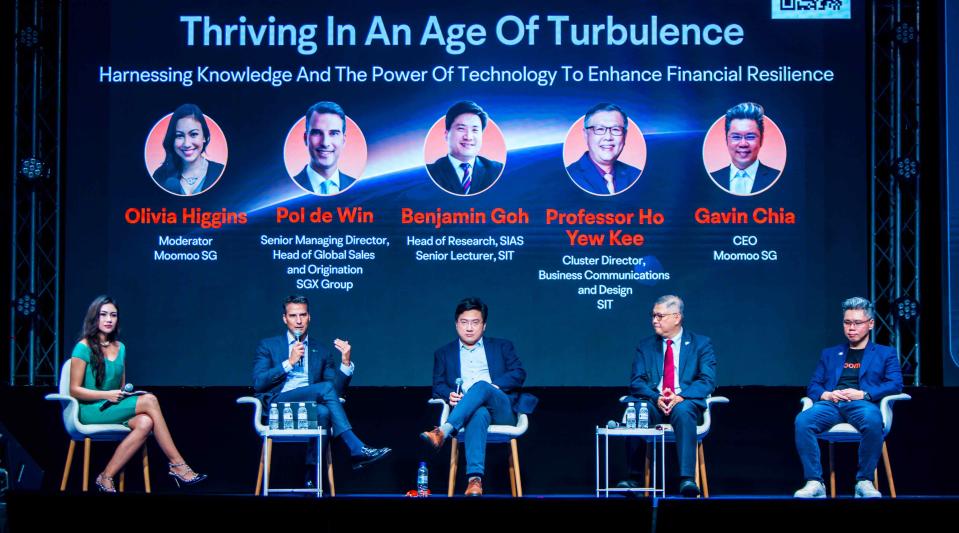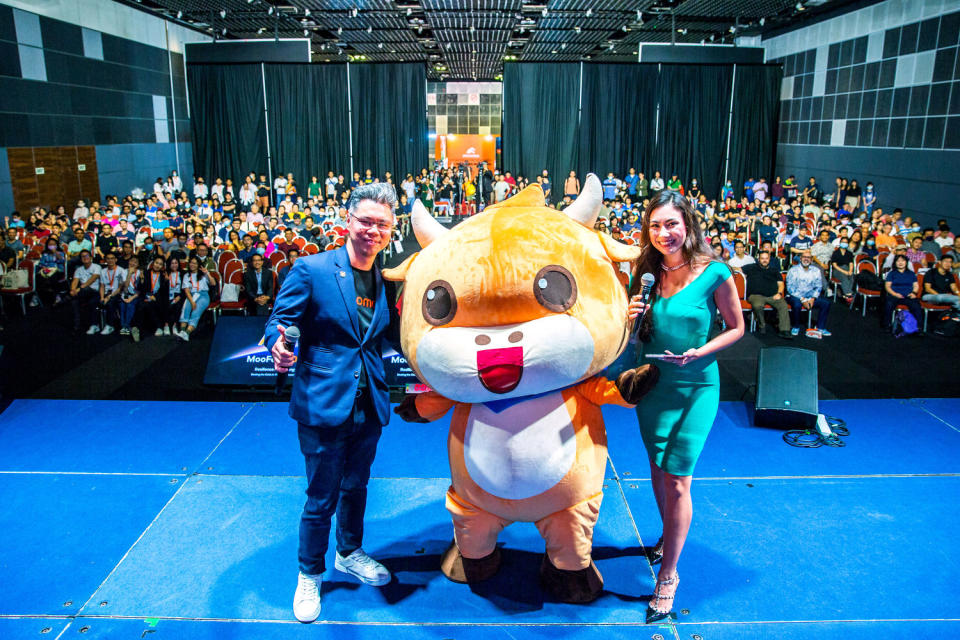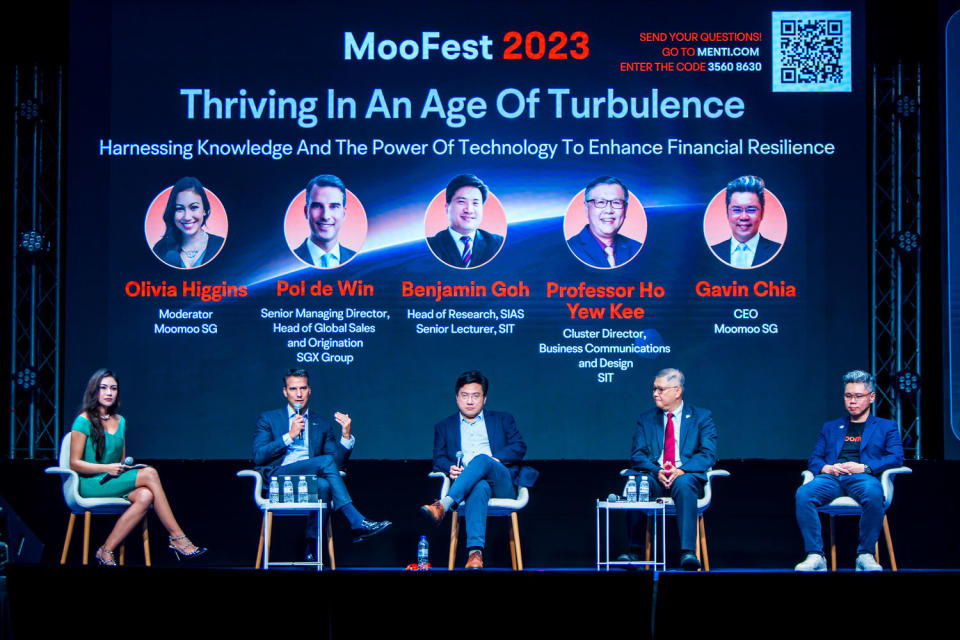New investors must work hard, use common sense and read research reports: MooFest 2023 panel

“What makes us uniquely human is the ability to make good decisions in an environment with incomplete information.”
Investing is not for the faint-hearted, but a good starting point for rookie investors is to combine common sense with hard work, says Prof Ho Yew Kee, cluster director of business, communication and design at the Singapore Institute of Technology (SIT). This will enable them to make sense of corporate and financial news from various sources.
“What makes us uniquely human is the ability to make good decisions in an environment with incomplete information. So, that means we triangulate; we pick up all the bits and pieces and put them together. That’s why investment is hard work. It takes effort, it takes time [and] it takes expertise,” says Ho, who was formerly the head of accountancy at the National University of Singapore (NUS) Business School.
Speaking on the sidelines of digital brokerage Moomoo’s flagship event MooFest on July 15, Ho urges retail investors to verify the information they receive. “FOLO”, or the fear of losing out, creates a “different set of dynamics”, he adds. “If you only invest based on what you hear from your friends, unless your friends are creating the trade, you are in trouble. By the time information cascades down to [retail investors], the money has already been made upstream; you will be buying at a high price.”
Ho appeals for financial literacy at the grassroots — “almost like a kampung spirit” — “where we as a kampung learn together through various means and through various opportunities in a credible manner, not just hearsay”.
Some 1,000 Moomoo Singapore users visited MooFest 2023 at Suntec City Convention Hall. With support from strategic partners SIT and the Securities Investors Association (Singapore) (SIAS), the free event featured speakers from the Singapore Exchange (SGX), SIT, SIAS, United Overseas Bank (UOB), Lion Global Investors, Fullerton Fund Management and Société Générale, among others.
Research reports are a useful yet overlooked source of information, says Benjamin Goh, head of research at SIAS. “Gone are the days where research reports are eight [to] 20 pages; all you need to do is just read the executive summary, just page one. You’ll get the gist of it and if you like, you can read more.”
Reports by Singapore brokerages are mostly free, adds Goh, who is also a senior lecturer at SIT. These reports, which are written by analysts from houses like DBS Group Research, UOB Kay Hian and OCBC Investment Research, contain key information about listed companies, their projected earnings and even share price forecasts.
“Not many people read research reports, so they're kind of leaving the low-hanging fruit there and they’re not picking it up,” says Goh. “They [would] rather turn to influencers on YouTube, which is kind of a bad idea.”

Starting small
Ho urges retail investors to get their feet wet. “Starting small is the most important thing. Go for the exchange-traded funds; go for marketplace diversification. I think as an investor, you need to know where your journey is [going] and take the appropriate action to start this journey. As you build your confidence [and] as you build knowledge, then you can, with calculated risk, broaden and deepen your investments.”
With technology, the bar to start investing is not too high, says Pol de Win, senior managing director and head of global sales and origination at SGX Group. “It becomes very easy to get started in the investment journey. You don’t have to start the investor journey when you have $100,000. You can start with $100 or $1,000. Later in your life, you will benefit from the compounded results of all of that. That is really something that should appeal to many of the investors who are starting out, [especially] young folks.”
Gavin Chia, chief executive officer of Moomoo Singapore, welcomes potential traders to test their investing strategies with paper trades on the digital brokerage. The simulated trading allows investors to experiment without having to risk losing their capital on the actual stock markets.
Fractional shares, coming soon to the Moomoo Singapore platform, will also allow investors to “trade with a single dollar”, adds Chia.

Opportunities ahead
Today’s markets make for a “complex investing environment”, says de Win. “Yields are no longer a given, rate uncertainty is there, so you have to be careful around it. But in uncertain environments, opportunities are always there to be taken.”
Which stocks are these investment experts eyeing in the latter half of the year?
To Chia, the aviation sector holds much promise. “The amount that I’ve paid for flight tickets has gone up a lot, two or three times. If you look at the [share price] movements, I have a sense that in the near term, I personally feel that the airline sector should benefit.”
Mid-caps “could be an idea”, notes Goh. “If you look at the US, you have the S&P 500 mainly driven by the top five technology companies. But once [the market] moves into a new cycle with lower interest rates, the financial pressure on the mid-cap stocks could lessen and that will unlock equity value for mid-caps.”
This extends to the Singapore stock market as well, adds Goh. “Mid-caps are generally overlooked in favour of the big boys like Tesla and Apple. But mid-caps could be one sector that could be interesting.”
As an educator, Ho says he believes in the efficient market. “Again, this is where common sense comes in. Look at the world; which industry will last in the long term? What are the things that they are doing in terms of the environmental, social and governance space or sustainability that [will] allow them to sail the company for the next 100 years?”
Ho urges investors to look ahead. “Which sectors are the most progressive? What is the next winning item 20 years from now? What will we continue to need in five, 10, 15, 20 years?”
At the end of the day, investors will always find themselves questioning their investment horizon, Ho adds. “Are you taking a bet or doing it for 10 years? They’re totally different.”

Investors here can also enjoy home ground familiarity.
SGX has seen just five company listings so far for 2023 — four on the Catalist and one secondary listing on the Mainboard. That does not mean this will stay this way and that stocks listed here are deemed unattractive, and de Win believes he can turn this around. “This is my life; it’s what I do. That’s why I’m very passionate about this,” he says in response to an audience question at a preceding panel.
Macro factors are “in our favour” for the next 10 years, adds de Win, with institutional and high-net-worth investors congregating in Singapore. “What we don’t realise is that we just haven’t really seen the supply of new economy [companies] from the region. You need many, many companies reaching maturity to supply the stock market. This is about to change, I think, [in] the next five years for this region.”
Photos: Moomoo Singapore
See Also:
Click here to stay updated with the Latest Business & Investment News in Singapore
Singapore Institute of Technology to establish "living labs" with Oracle and Salesforce
Get in-depth insights from our expert contributors, and dive into financial and economic trends

 Yahoo Finance
Yahoo Finance 